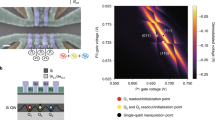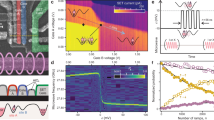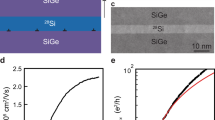Abstract
Semiconductor qubits have a small footprint and so are appealing for building densely integrated quantum processors. However, fabricating them at high densities raises the issue of noise correlated across different qubits, which is of practical concern for scalability and fault tolerance. Here, we analyse and quantify the degree of noise correlation in a pair of neighbouring silicon spin qubits around 100 nm apart. We observe strong interqubit noise correlations with a correlation strength as large as 0.7 at around 1 Hz, even in the regime where the spin–spin exchange interaction contributes negligibly. We find that fluctuations of single-spin precession rates are strongly correlated with exchange noise, showing that they have an electrical origin. Noise cross-correlations have thus enabled us to pinpoint the most influential noise in our device. Our work presents a powerful tool set to assess and identify the noise acting on multiple qubits and highlights the importance of long-range electric noise in densely packed silicon spin qubits.
This is a preview of subscription content, access via your institution
Access options
Access Nature and 54 other Nature Portfolio journals
Get Nature+, our best-value online-access subscription
$29.99 / 30 days
cancel any time
Subscribe to this journal
Receive 12 print issues and online access
$209.00 per year
only $17.42 per issue
Buy this article
- Purchase on Springer Link
- Instant access to full article PDF
Prices may be subject to local taxes which are calculated during checkout




Similar content being viewed by others
Data availability
All data in this study are available from the Zenodo repository at https://doi.org/10.5281/zenodo.7467057. Source data are provided with this paper.
References
de Leon, N. P. et al. Materials challenges and opportunities for quantum computing hardware. Science 372, eabb2823 (2021).
Barends, R. et al. Superconducting quantum circuits at the surface code threshold for fault tolerance. Nature 508, 500–503 (2014).
Ballance, C. J., Harty, T. P., Linke, N. M., Sepiol, M. A. & Lucas, D. M. High-fidelity quantum logic gates using trapped-ion hyperfine qubits. Phys. Rev. Lett. 117, 060504 (2016).
Rong, X. et al. Experimental fault-tolerant universal quantum gates with solid-state spins under ambient conditions. Nat. Commun. 6, 8748 (2015).
Yoneda, J. et al. A quantum-dot spin qubit with coherence limited by charge noise and fidelity higher than 99.9%. Nat. Nanotechnol. 13, 102–106 (2018).
Noiri, A. et al. Fast universal quantum gate above the fault-tolerance threshold in silicon. Nature 601, 338–342 (2022).
Xue, X. et al. Quantum logic with spin qubits crossing the surface code threshold. Nature 601, 343–347 (2022).
Klesse, R. & Frank, S. Quantum error correction in spatially correlated quantum noise. Phys. Rev. Lett. 95, 230503 (2005).
Google Quantum AI. Exponential suppression of bit or phase errors with cyclic error correction. Nature 595, 383–387 (2021).
Wilen, C. D. et al. Correlated charge noise and relaxation errors in superconducting qubits. Nature 594, 369–373 (2021).
von Lüpke, U. et al. Two-qubit spectroscopy of spatiotemporally correlated quantum noise in superconducting qubits. PRX Quantum 1, 010305 (2020).
Szańkowski, P., Trippenbach, M., & Cywiński, Ł. Spectroscopy of cross correlations of environmental noises with two qubits. Phys. Rev. A 94, 012109 (2016).
Paz-Silva, G. A., Norris, L. M. & Viola, L. Multiqubit spectroscopy of Gaussian quantum noise. Phys. Rev. A 95, 022121 (2017).
Chan, K. W. et al. Assessment of a silicon quantum dot spin qubit environment via noise spectroscopy. Phys. Rev. Appl. 10, 044017 (2018).
Struck, T. et al. Low-frequency spin qubit energy splitting noise in highly purified 28Si/SiGe. npj Quantum Inf. 6, 40 (2020).
Boter, J. M. et al. Spatial noise correlations in a Si/SiGe two-qubit device from Bell state coherences. Phys. Rev. B 101, 235133 (2020).
Gutiérrez-Rubio, Á. et al. Bayesian estimation of correlation functions. Phys. Rev. Res. 4, 043166 (2022).
Kerckhoff, J. et al. Magnetic gradient fluctuations from quadrupolar 73Ge in Si/SiGe exchange-only qubits. PRX Quantum 2, 010347 (2021).
Reed, M. D. et al. Reduced sensitivity to charge noise in semiconductor spin qubits via symmetric operation. Phys. Rev. Lett. 116, 110402 (2016).
Paladino, E., Galperin, Y., Falci, G. & Altshuler, B. L. 1/ f noise: Implications for solid-state quantum information. Rev. Mod. Phys. 86, 361–418 (2014).
Stano, P. & Loss, D. Review of performance metrics of spin qubits in gated semiconducting nanostructures. Nat. Rev. Phys. 4, 672–688 (2022).
Burkard, G., Ladd, T. D., Nichol, J. M., Pan, A. & Petta, J. R. Semiconductor spin qubits. Rev. Mod. Phys. 95, 025003 (2023).
Xue, X. et al. Benchmarking gate fidelities in a Si/SiGe two-qubit device. Phys. Rev. 9, 021011 (2019).
Mills, A. et al. Two-qubit silicon quantum processor with operation fidelity exceeding 99%. Sci. Adv. 8, eabn5130 (2021).
Gonzalez-Zalba, M. F. et al. Scaling silicon-based quantum computing using CMOS technology. Nat. Electron. 4, 872–884 (2021).
Yoneda, J. et al. Quantum non-demolition readout of an electron spin in silicon. Nat. Commun. 11, 1144 (2020).
Noiri, A. et al. Radio-frequency-detected fast charge sensing in undoped silicon quantum dots. Nano Lett. 20, 947–952 (2020).
Eshraghi, M. J., Sasada, I., Kim, J. M. & Lee, Y. H. Characterization of a low frequency magnetic noise from a two-stage pulse tube cryocooler. Cryogenics 49, 334–339 (2009).
Kalra, R. et al. Vibration-induced electrical noise in a cryogen- free dilution refrigerator: characterization, mitigation, and impact on qubit coherence. Rev. Sci. Instrum. 87, 073905 (2016).
Acknowledgements
We are grateful to Á. Gutiérrez-Rubio for fruitful discussions. Part of this work was financially supported by MEXT Quantum Leap Flagship Programme (MEXT Q-LEAP) grant no. JPMXS0118069228 (S.T.), JST PRESTO grant nos. JPMJPR21BA (J.Y.) and JPMJPR2017 (T.N.), JST Moonshot R&D grant nos. JPMJMS2065 (J.Y., T.N.) and JPMJMS226B (S.T., T.N.), JST CREST grant no. JPMJCR1675 (S.T., D.L.), JSPS KAKENHI grant nos. JP21K14485 (J.Y.), JP23H01790 (J.Y., A.N.) and JP23H05455 (J.Y., K.T.), Swiss National Science Foundation and NCCR SPIN grant no. 51NF40-180604 (D.L.), The Precise Measurement Technology Promotion Foundation (J.Y.), Suematsu Fund (J.Y.) and Advanced Technology Institute Research Grants (J.Y.).
Author information
Authors and Affiliations
Contributions
J.Y. conceived and performed the experiment. J.S.R.-A. and P.S. assisted J.Y. with data analysis and performed device modelling. K.T. fabricated the device. A.N. and T.N. contributed to the measurement setup. D.L. and S.T. supervised the project.
Corresponding authors
Ethics declarations
Competing interests
The authors declare no competing interests.
Peer review
Peer review information
Nature Physics thanks Natalia Ares, Łukasz Cywiński and the other, anonymous, reviewer(s) for their contribution to the peer review of this work.
Additional information
Publisher’s note Springer Nature remains neutral with regard to jurisdictional claims in published maps and institutional affiliations.
Supplementary information
Supplementary Information
Supplementary Sections I–VI and Figs. 1–12.
Source data
Source Data Fig. 1
Numerical source data.
Source Data Fig. 2
Numerical source data.
Source Data Fig. 3
Numerical source data.
Source Data Fig. 4
Numerical source data.
Rights and permissions
Springer Nature or its licensor (e.g. a society or other partner) holds exclusive rights to this article under a publishing agreement with the author(s) or other rightsholder(s); author self-archiving of the accepted manuscript version of this article is solely governed by the terms of such publishing agreement and applicable law.
About this article
Cite this article
Yoneda, J., Rojas-Arias, J.S., Stano, P. et al. Noise-correlation spectrum for a pair of spin qubits in silicon. Nat. Phys. 19, 1793–1798 (2023). https://doi.org/10.1038/s41567-023-02238-6
Received:
Accepted:
Published:
Issue Date:
DOI: https://doi.org/10.1038/s41567-023-02238-6
This article is cited by
-
Hamiltonian phase error in resonantly driven CNOT gate above the fault-tolerant threshold
npj Quantum Information (2024)
-
Non-Markovian cost function for quantum error mitigation with Dirac Gamma matrices representation
Scientific Reports (2023)
-
Spatial correlations of charge noise captured
Nature Physics (2023)



